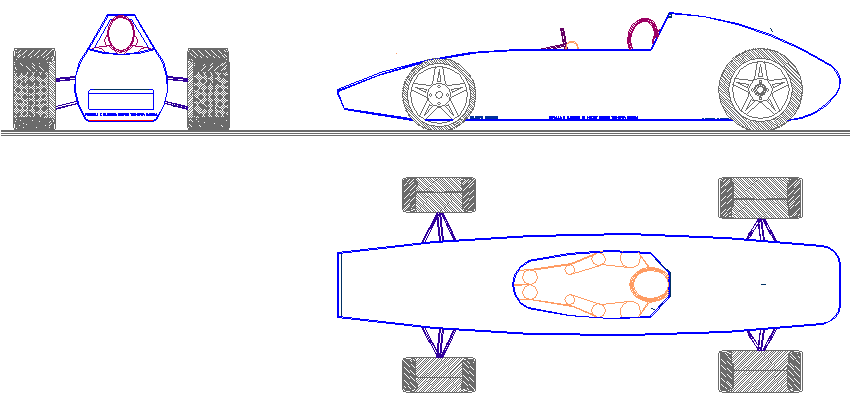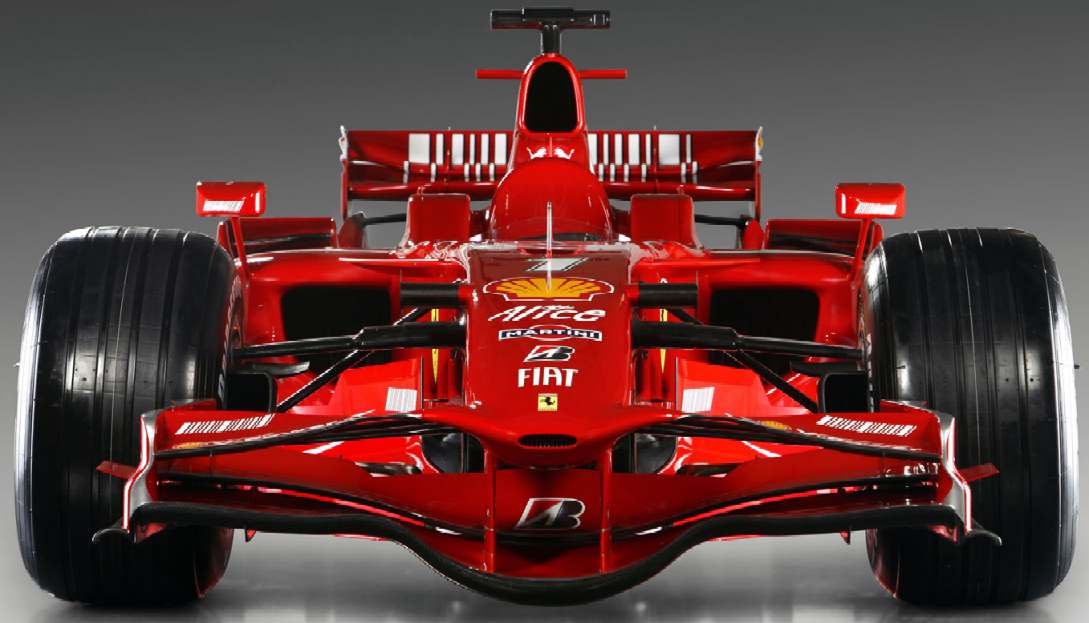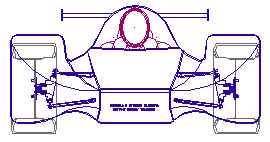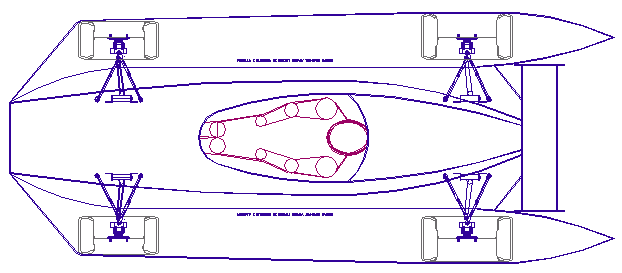FORMULA
E
Two
methods of replenishing energy are to be allowed from 2015 in Formula E:
a)
Swapping cars while a spare is being fast charged.
b)
Instant battery cartridge exchanges.
The
drawing above is of a basic Formula E design which has the Bluebird™FE
system built into the chassis. This proposed prototype carries a very
large Lithium
battery cartridge, which can be changed in around 10-15 seconds. Since
the average Formula 1 pits stop is not much quicker, the Bluebird™FE
energy transfer system should be competitive. Please also note that this
cartridge system is compatible with fuel
cells, should any team want to give that a go.
The
Bluebird™ FE system does not need special loaders. The high speed
loader is part of the chassis. The secret is in the design - which, as
you can see can be incorporated in a fairly regular layout. Any Formula
E team that wants to incorporate such a system for the 2015 series, will
be granted a free developers license.
The
inventor of the patent system is
now working on an enclosed cockpit design. He is not a formula racing
car designer, he just wants to be sure that the system as conceived,
will allow sufficient storage space for a decent length race. The latest
improvements will go to a further improvement patent. Open or closed
wheel/cockpit design, it makes little difference for operation of the
loading system, which is the key ingredient to 10 second pit stop
recharging.
The
cartridge design in 246 liters in capacity, more than enough for 80+kW/hrs
of energy. Such capacity will double the range of any EV road car today
[April 2013].

FORMULA
ONE
In
Formula One, mid race refuelling is currently not permitted by the regulations, and cars make pit stops with the primary purpose of changing tyres. Teams sometimes also make adjustments to the front and rear wings and perform minor repairs, most commonly replacing the nose and front wing assembly. Pit strategies generally call for between one and three scheduled stops, depending on the circuit. The driving between pit stops are commonly known as 'stints'.
When the car is approximately one lap away from making its stop, the team's pit crew will set up fresh
tires and all needed pit equipment. Because of the overhead pneumatic rig, the team may have all pit mechanics in position prior to the car's arrival, with the exception of the rear jack man.
Interestingly, unlike almost all other forms of racing that feature routine pit stops, Formula One rules limit teams to a single pit crew for the mandatory two cars entered. Therefore, teams must stagger their pit schedules so that only one of their two cars is in the pits at any given time. Most other racing series that feature routine pit stops permit each car its own pit stall and crew.
F1
REFUELLING
Refuelling was permitted from the 1994 season until the end of the 2009 season. During this period, a pit stop involved about twenty mechanics, with the aim of completing the stop as quickly as possible. Stops generally lasted for six to twelve seconds depending on how much fuel is put into the car.
If there is a problem, such as a fuel pump failing or the engine stalling, or repairs having to be made, it can take much longer. Cars were
fuelled at a rate of more than 12 litres per second. This is accomplished by a fairly complex closed system that pumps air out of the car's fuel tank as the fuel is being pumped in.
As refuelling is a potentially hazardous situation, the mechanics wore fire-resistant multi-layer suits & flame-resistant gloves, long underwear, balaclava, socks and shoes, which have to meet the guidelines set by
FIA Standard 8856-2000.
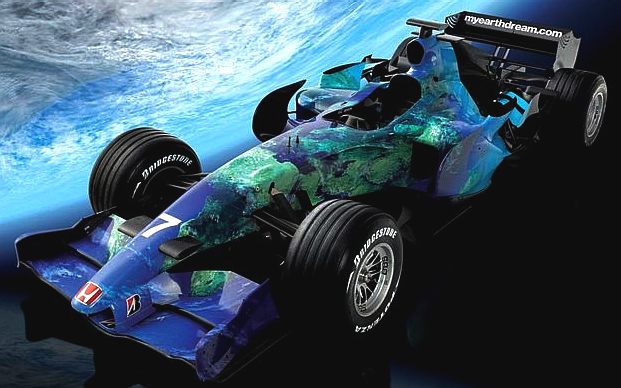
PIT
STOP HISTORY
In motorsports, a pit stop is where a racing vehicle stops in the pits during a race for
refueling, new tires, repairs, mechanical adjustments, a driver change, or any combination of the above. Not all are allowed in all formulae.
The pits usually comprise a pit lane which runs parallel to the start/finish straight and is connected at each end to the main track, and a row of garages (usually one per team) outside which the work is done. Pit stop work is carried out by anywhere from five to twenty mechanics (also called a pit crew), depending on the series regulations, while the driver waits in the vehicle (except where a driver change is involved).
Depending on the circuit, the garage may be located on pit lane or in a separate area. Most North American circuits feature a pit lane with number of pit stalls (typically 30-50) and a pit wall which separates the pit lane from the infield, with the garages (if used) on a separate road in the infield. In races where there are different series racing together, each series has its own separate garage or are parked in their own area. Circuits in other areas (used in
F1) typically have the individual garage stalls open directly onto the pit lane through the team's assigned pit stall. In American English, it is common to drop the definite article and just refer to "pit road", whereas in British English one would always refer to "the pit lane".
For all but the shortest races, refueling is the primary purpose of a pit stop. Race engines generate high power but also burn fuel at an extreme rate, and many races will require multiple stops for fuel based on distance alone. However, many other adjustments can be performed during a pit stop, and some can even be performed without taking any more time than refueling. By making pit stops, cars can carry less fuel, and therefore be lighter and faster. During refueling, the tires can be changed as well, which permits the use of softer tires that wear faster but provide more grip. Teams usually plan for each of their cars to pit following a planned schedule, with the number of stops determined by the fuel capacity of the car, tire lifespan, and tradeoff of time lost in the pits versus how much time may be gained on the race track through the benefits of pit stops. Choosing the optimum pit strategy of how many stops to make and when to make them is crucial in having a successful race. It is also important for teams to take competitors' strategies into account when planning pit stops, to avoid being "held up" behind other cars. An unscheduled or extended stop, such as for a repair, can be very costly for a driver's chance of success, because while the car is stopped for service, cars remaining on the track can rapidly gain distance on the stopped car.
In most series (except NASCAR), pit assignments may be assigned by points standings, race results, or previous qualifying results before the start of the race meet. In NASCAR and in INDYCAR's Indianapolis 500, typically pit assignments are made after qualifying, with the fastest qualifiers choosing their pit stall first.
STRATEGY
In any racing series that permits scheduled pit stops, pit strategy becomes one of the most important features of the race; this is because a race car travelling at 100 miles per hour (160 kilometres per hour) will travel approximately 150 feet (45 metres) per second. During a ten-second pit stop, a car's competitors will gain approximately one-quarter mile (one-half kilometre) over the stopped car.
However, the car that made the additional pit stop will run faster on the race track than cars that did not make the stop, both because it can carry a smaller amount (and thus lower weight) of fuel, and will also have less wear on its tires, providing more traction and allowing higher speeds in the corners. In racing series where teams have their choice of different compound tires, the lower tire wear may be enough to allow the team to choose to use a tire with a softer rubber compound that provides increased grip at the expense of faster wear; going longer between stops may even cause enough wear on the softer tire to cause the tires to fail.
Because of this, race teams plan a pit strategy prior to the start of every race. This is a schedule for each car's planned pit stops during the race, and takes into account factors such as rate of fuel consumption, weight of fuel, cornering speed with each available tire compound, rate of tire wear, the effect of tire wear on cornering speed, the length of pit road and the track's pit road speed limit, and even expected changes in weather and lighting conditions. The pit strategy does not just include a schedule of when pit stops will happen; it also includes what service and adjustments are scheduled for each pit stop, particularly in endurance racing, where scheduled changes of wear-limited parts such as brake pads may be planned for specific points during the race. The pit strategy is calculated carefully so that the amount of time to be "given away" to other competitors in pit stops is balanced out by the time gained while on the track, resulting, theoretically, in the shortest possible time to cover the scheduled distance.
However, a team's pit strategy is not a fixed, immutable thing; it is subject to change during the race to take into account the unpredictable events that happen in every race. In road racing, for example, if the weather changes from dry to rain, teams will be forced to recalculate their pit strategy based on the unscheduled stop to change from dry-weather "slick" tires to treaded wet-weather tires.
Full-course caution periods often see mass pit stops by many teams, hoping to take advantage of the slowed pace to reduce the ground lost to other teams while making pit stops; this forces teams that do so to immediately recalculate their pit strategy to optimize it for the remaining race distance after the stop.
Even when a team chooses not to take advantage of the opportunity to stop during a full-course caution, it can still result in significant changes to pit strategy; under caution, the cars run at a reduced speed that results in greatly reduced tire wear and fuel burn for a distance
traveled.
Depending on the circumstances, this may be enough for a team to gain more by choosing not to pit, hoping that the reduced fuel burn and tire wear will allow them to make one pit stop fewer than the other teams, allowing them to gain distance and time on their opponents. At tracks noted for frequent full-course cautions, teams may even plan their entire race strategy around this, using a suspension and aerodynamic setup suited to short sprints instead of extended runs to gain positions in the short bursts of green-flag racing, and planning their pit strategy on the assumption that cautions will extend their fuel mileage and tire wear enough to make fewer stops than would otherwise be needed to complete the race distance.
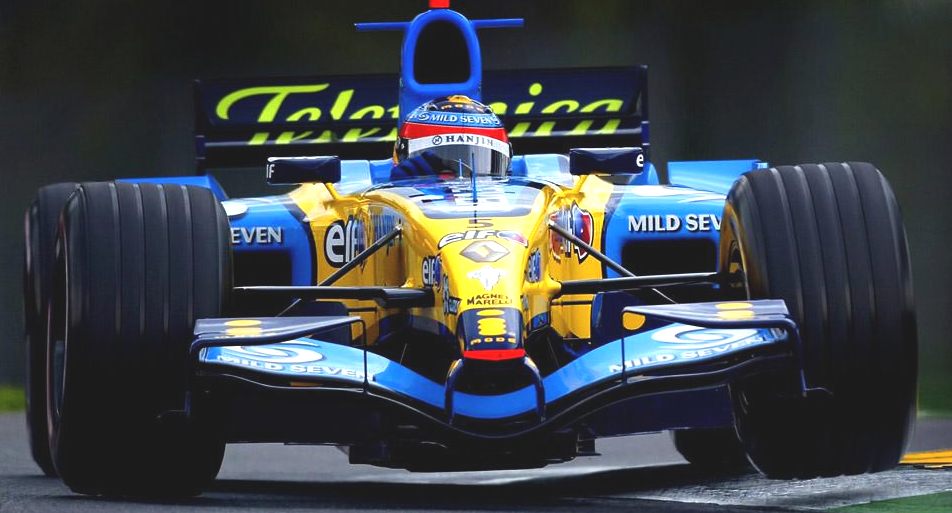
SERVICING
During a scheduled pit stop, the team's pit crew services the car as swiftly as possible, completing a number of different services. The most visible services performed are
refueling the car and changing tires.
Other services performed in routine pit stops include removing debris from radiator air intakes; cleaning the windshield; and making adjustments to tire pressure, suspension settings, and aerodynamic devices to optimize the car's performance for the current conditions. In endurance racing, scheduled driver changes and brake pad replacements are also considered "routine" service when done as part of a scheduled pit stop.
An unscheduled pit stop may see other service performed; because unscheduled stops are usually due to damage or mechanical problems, they frequently see emergency repairs performed on the car. These tend to have extremely long duration, due to the need to diagnose the car's problems prior to the time-consuming repairs.
FORMULA
1 PIT CREW
The lollipop man holds the team's pit sign, helping the driver identify his pit stall on a possibly crowded pit road. During the stop, he holds the sign in position to remind the driver to keep his brakes on while tires are being changed, and then to remember to put the car in first gear once the jacks are lowered. He also gives the driver the sign to depart his pit stall by raising the sign from in front of the driver.
In 2008, Ferrari used a traffic light system to replace the lollipop man. A red light signalled the driver to keep his brakes on, an amber light to put the car in first gear, and a green light to signal the driver to depart his pit stall. However, after
human error caused Felipe Massa to drive off with his fuel hose still attached during the Singapore Grand Prix, Ferrari reverted to the Lollipop Man system. However, in the 2010 and current 2011 season,
Ferrari have once again reverted to a traffic light system, as have some other teams.
The four tyre changers, one at each corner of the car, have the sole responsibility of using a pneumatic wrench to remove the car's single locking lug nut from each tyre, then reinstall it on the new tyre.
Eight tyre carriers are used, two at each corner of the car, one assigned the task of removing the old tyre from the car, and one to install the new tyre on it. The front new tyre carriers also have the responsibility of adjusting the car's front wing during the stop.
The front and rear jack men use simple lever-type jacks to lift the car and permit the changing of tyres. The job of front jack man is considered the most hazardous, as it requires standing directly in front of the car as it enters its pit stall. By contrast, due to the location of his duties directly behind the car, the rear jack man is the only team member not in his working position before the car enters its pit stall.
The fire extinguisher man does not actually work on the car; instead, he stands ready with a hand-held fire extinguisher to try to stop any accidental fires that may occur during a stop, at least long enough for the pit crew and driver to evacuate. This job became standard following Jos Verstappen's 1994 pit fire.
The starter man does not normally work on the car. His job is to stand ready with a starter tool to restart the car should the driver stall his engine during the stop.
